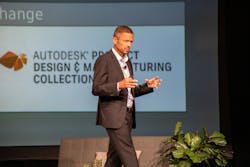Beyond the theory of the digital manufacturing age is the reality of actually designing and manufacturing products. Stephen Hooper, the vice president and general manager of Autodesk’s Fusion 360 technology, understands that disconnect.
“We’ve put out a compelling vision of future, but it’s hard to correlate that with what we’re actually able to deliver today,” Hooper said at the company’s annual Accelerate conference at the headquarters of Autodesk partner Steelcase in Grand Rapids, Mich. “It’s difficult to visualize how to employ the technology today. We need to rationalize that technology.”
In his Sept. 4 Accelerate keynote presentation, and in a later press briefing, Hooper said the convergences in manufacturing—of technology and tradition as well as of data and design—are creating new opportunities to meet the speed and flexibility needed by manufacturers, as well as by their end-users.
“We’re rapidly changing the way we go through the manufacturing process,” Hooper said in his keynote. “As software vendors, we often ignore the most important part—the human beings that have to work through this process. It’s that where we think we have a chance to disrupt the process.
“It’s a convergence of design and manufacturing,” Hooper continued. “It puts your venture at the center of the process. You can put it all on a single platform. You can connect the manufacturing process to the iterative design process. It can be delivered on a cloud platform and connect everyone in the supply chains. You have manufacturers, customers, and designers on a single platform.”
To accomplish this, Autodesk has made a significant investment in generative design, which allows dozens of potential design solutions to be created from a single set of constraints. This allows for faster decisions to be made by examining a wider variety of potential solutions.
“Generative is our big bet, but not going to serve that on our own,” Hooper said at the press briefing. “We see it moving from generative design for a part to generative design for a product. We’re looking at assemblies rather than just parts. That’s out big technology bet. It will fundamentally change the way you do business in the same way CAD did when you moved off the drawing board.”
Generative design is an additional tool for the design engineer—but that’s not always the first reaction. The issue of human interaction with technology is something Hooper is aware of. “We want to make it a collaborative process between the human and the algorithm,” he said. “It’s a paradigm shift…It’s about having the computer assist you with solving the problem rather than just documenting it. We need to be able to give [the designer] an on-ramp. Now they can see the results they would have produced themselves. What designer can do is drive innovation.”
Autodesk’s product plan is to focus on three areas of the design and manufacturing process:
- Data platform: The ability to describe every aspect of product design.
- Advanced manufacturing: Integrating Autodesk acquisitions into the larger portfolio.
- Generative design: How to employ data from a singular platform, and what benefits can be derived from the collection of that data.
That includes the use of fully integrated electronic design, allowing designers to build full schematic representations of a 3D circuit board.
Where Hooper sees the fastest adoption of generative design is in research and development. “R&D shops love it,” he said. “They are a self-contained microcosm and they love this integrated nature…R&D centers are less constrained by legacy data, they want to integrate design and manufacturing, and they embrace generative because gets them to market faster.”
At any level of the design process, the opportunity to access data is the key to improving both the speed of the designing and the manufacturing processes. “There’s a convergence between design and manufacturer and construction,” Hooper noted. “There’s a convergence between industries. Fundamentally, our principle is about democratizing access to information in a more integrated environment.”
About the Author

Bob Vavra
Editor Emeritus, Machine Design and Power & Motion
Bob Vavra is the former senior content director of Machine Design and Power & Motion.

